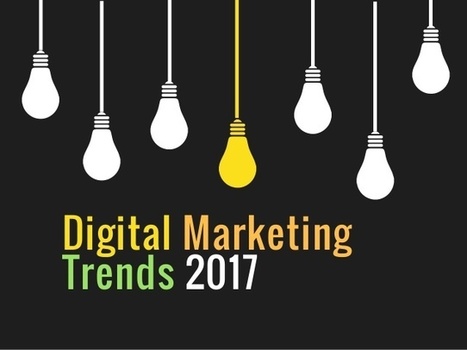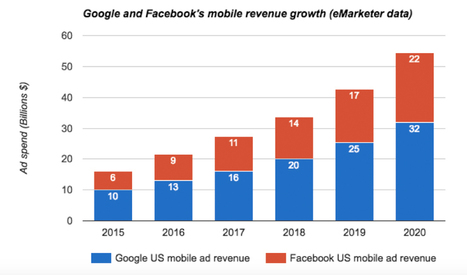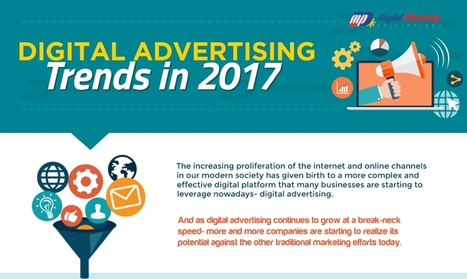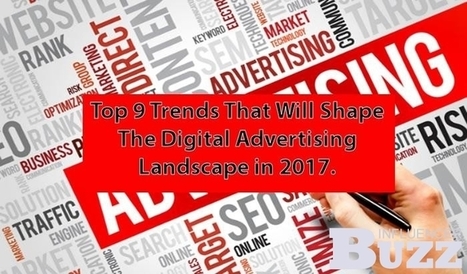 Your new post is loading...
 Your new post is loading...
The tide began turning against the duopoly late last year when the fake news epidemic illustrated for many the lack of brand safety on Facebook and Google. Brands found out that their ads were showing up next to hate speech or agenda-driven fake news and were understandably miffed.
Fueling that anger, Facebook was caught drastically inflating its time-spent metrics for video by as much as 60-80%. More recently, Google was caught doing something similar with AMP, its mobile-based publishing platform.
Though both have subsequently agreed to third-party analyses of their operations, for many marketers, that was cold comfort since (in Facebook’s case, at least), the abuses had been happening over a long period of time.
In late January, the industry found a spokesman for their discontent with Marc Pritchard, Procter & Gamble’s global CMO, who chastised the industry for its lack of transparency. More recently, Havas pulled its buys on Google and YouTube for UK-based clients in the name of brand safety. ...
In summary, here are the key takeaways from the infographic below that tells us the latest shifts in digital advertising this 2017: - Increased usage of mobile ad blockers
- Increased monetization of Google AMP and Facebook
- Instant Articles
- Revenue on desktop advertising will continue to level down; Mobile advertising will experience massive growth
- Google and Facebook continues to be the most utilized platform in digital advertising
- Programmatic advertising will gain more popularity
- Outstream videos will gain more popularity
- Increased utilization of Chatbots....
The French advertising powerhouse and the British government want more control over where their ads run. Havas is pulling all spending from Google and YouTube in the United Kingdom, citing the desire to have more control of its inventory in hopes of keeping brands away from inappropriate or offensive content.According to a report in The Guardian, the French advertising giant’s decision came after talks broke down related to Google’s inability to “provide specific reassurances” related to where video and display ads appear. The report cites content showing up in YouTube alongside videos of white nationalists and terrorists. The news about Havas—which spends around 175 million euros ($188.2 million) annually on digital advertising clients in the U.K.—comes alongside a report that the British government and other organizations also pulled their ads from the tech giant....
In January 2017, Small Business Trends released the results of a survey of over twenty-six-hundred small business owners, revealing that sixty-two percent of them believe Facebook ads are ineffective. With complaints of little-to-no ROI, these entrepreneurs say they will not use Facebook advertising again. Some experts, however, challenge this viewpoint, saying that properly targeted Facebook ads do indeed, provide results. "When businesses don't see the results they hope for, it's usually because they haven't done enough testing on their ad copy, visuals, and the ideal combination of information to target the right audience," says Vitruvian Digital Advertising Founder, Kristie McDonald. Jeanine Blackwell, Founder of The Launch Lab agrees, saying that marketers aren't asking themselves the right questions to determine an effective target market for their ad campaigns. "The problem is that most advertisers only use the simplest of criteria to let Facebook know who they want to see their ads, such as gender, age, and income," says Blackwell. "When you couple this information with more insights on the behaviors and unique interests of your audience, you can deliver your ads only to people likely to be interested in what you offer." Both experts agree that a testing budget as small as five or ten dollars a day, focusing on different mixes, can tell you what you need to know before you begin to invest larger amounts in your campaign....
If anything is going to convince a smoker to quit, it's a judgmental, passive-aggressive, coughing billboard. At least, that's the ostensible premise of a new campaign from Swedish pharmacy Apoteket Hjärtat and agency Åkestam Holst. The digital poster uses outdoor smoke detectors to identify any nearby smokers and shame them by sending the man on the screen into a hacking fit, according to a case study video promoting the ad. It then displays a series of nicotine patches and other kick-the-habit products, because obviously, the smoker is going to be most receptive to a pitch right after having his or her moment of self-destructive indulgence interrupted by a virtual asshole....
White Ops today reported that a group of Russia-based cybercriminals is stealing $3 million to $5 million daily from premium-video-focused advertisers. The fraud-fighting player discovered an extensive network of automated web browsers called Methbot, which it says consists of custom software running on data servers in Amsterdam and Dallas. According to White Ops, Methbot runs differently than common fraud bots, which usually infect computers with malicious software that serve ads seen by zero people. The ring of fraudsters created approximately 600,000 counterfeit IP addresses that appear to be legitimate, the researchers said, by hacking into a pair of the world's regional internet registries. The nefarious operators then registered those IP addresses to actual online service providers such as Verizon, Comcast and Spectrum (formerly Time Warner). This tactic made their faux internet activity appear genuine before commanding their bot army to generate 200 million to 300 million impressions and charging brands for premium video ads. ...
"We understand that the environment is changing inextricably, but what do we do now to prepare for this new reality?”
I had become so accustomed to describing the changes in content consumption and its implications for marketers, media companies, and tech-enabled content platforms that I was taken aback.
The nods among her team made it abundantly clear that “what now?” was more than a theoretical question, and one that needed to be addressed ASAP.
Thus, herewith are five practical predictions on the future of digital advertising creativity and real-world recommendations on what to do now to prepare....
Our industry faces a well-known duopoly, with Facebook and Google commanding an ever-increasing share of digital ad spend, both in the U.S. and globally. I recently dug into the data and forecasts available, to better quantify (for my own benefit and hopefully yours!) just how much Facebook and Google are eating digital.
Global ad spend, across all channels (digital, TV, print, radio, outdoor, etc.) is growing annually on average by 5.6 percent from 2015 to 2020, and will reach $674 Billion from $513 Billion in 2015.
The U.S. market will represent 35 percent of the global ad market, reaching $234 Billion by 2020 with a slightly slower growth rate compared to the global average, at 5.0 percent from 2015 to 2020. This is expected as rapidly developing markets in the East and a growing middle class represent new markets on which advertisers can focus.
45% Of U.S. Ad Spend Will Be Digital
33 percent of ad spend in the U.S. was digital last year and that is expected to reach 45 percent by 2020. In real numbers, that’s a $60-billion market growing to $105-billion, with a Compounded Annual Growth Rate (CAGR) of 11.9 percent.
The growth of digital is more than 2 times higher than the growth of the overall ad market, which represents a tremendous opportunity for digital businesses. More people are accessing content online and more advertisers are spending their budgets online. Will the rising tide lift all ships?...
Both current and former customers of the outdoor-clothing company Patagonia, for example, are more likely to consider themselves quite knowledgeable when compared to other shoppers, yet less equipped with social skills than the Lord & Taylor crowd. People who shop at Hot Topic, which caters to a younger, more alternative demographic, see themselves as highly imaginative, while patrons of Jos. A. Bank, which sells men's suits and business casual attire, see themselves as leaders.
Overall, these distinct personality types reveal the power of marketing, if done right.
One report anticipates that the retail industry alone will spend $15.09 billion on digital ads in 2016, followed by $16.95 billion in 2017 — a 12% increase. While it's important to know the best location to place an ad, knowing the personality of your intended audience is just as crucial....
Print ads were once the standard format for creative advertising. But advertising dollars are increasingly going toward digital outlets, and print advertising is now seen as an expensive and untrackable media format. You would think the category is void of innovative ideas, but that’s certainly not the case. In fact, many brands are finding new ways to merge the digital and physical world through magazine and newspaper ads. Here are 15 print ads that should make you rethink the word "traditional."...
The Top Thirty Global Media Owners report is a unique ranking of the world’s largest media companies by media revenue, as estimated by Zenith. The report was launched in 2007 and was last published by Zenith in 2015. Zenith defines media revenue as all revenue deriving from businesses that support advertising, to determine which companies are most important for the marketing industry.*
There are four media giants among the top 30 global media owners – Facebook, Baidu, Yahoo and Microsoft – and all have risen up the ranking this year. Facebook has moved up from 10th place last year to 5th place this year; Baidu has moved up from 14th to 9th; Yahoo from 18th to 15th; and Microsoft from 21st to 17th. Facebook is the fastest-growing media owner in our top 30, with media revenues up 65% on last year. Baidu is second-fastest (up by 52%) and Alphabet is third (up by 17%).
Between them, the five digital giants generated US$88bn in media revenue, which is 34% of all the revenues generated by our top 30 companies, and represents 65% of the entire global internet advertising market. Their collective dominance of digital advertising means that these five companies have captured most of the gains from its rapid growth. Digital adspend has grown at an average of 18% a year for the past five years, driven by the spread of mobile technology, the rise of social media and online video, and improved advertising technology, such as programmatic buying and local real-time search. Adspend across all other media has grown by just 0.6% a year....
|
Blockchain, best known so far in the financial space as the technology underpinning bitcoin, is essentially a massive, shared Excel sheet that can have many uses. These range from figuring out whether tuna is sustainably fished to whether the handbag you bought is counterfeit. But in advertising, the theory is turning into practice thanks to a host of different companies all using it to track ad impressions in digital media. The key is that blockchain, and adchain, theoretically lets multiple parts of the industry work together with no dependency on one party’s data. “If it’s immutable and decentralized, then you can align incentives,” said Brook. Right now, adchain will embed a tracker in the xml of a creative asset — and in real time, show you who is watching it or if viewability standards aren’t being met. Here’s what that theoretically looks like in the adchain if it’s about figuring out if an impression was real: A buyer buys an impression, which is encrypted in a block, and then broadcasted to every single participant on the chain. The impression is verified by the publisher, then added to the ledger. Everyone in the blockchain gets to see the impression event and approve it.
Last week, adtech company MetaX launched “adchain,” a use of the blockchain ledger to essentially tag a piece of creative and then follow it on the internet to figure out whether it was seen, who saw it, where it actually ran, conversion rates and how budget was spent along the chain....
Welcome to Personal Marketing at scale This new buzz phrase might seem like just another trending marketing gimmick, but the potential it holds seems to the something that can transform our approach to marketing altogether, permanently.I don’t know who you are, but I’m going to find you and advertise to you Personal marketing at scale, in a nutshell, is the ability to target customers according to their unique needs with different creative messages rather than the one-ad-fits-all advertisements that plague us.. With this kind of digitalization, it is now possible to custom design an advertisement based on target’s location, interests, demographics, purchase history, in a way that seems personally relevant to the consumer. With this, unique brand positioning would become a thing of the past, and it is even possible to have entirely different voices for the same brand to appeal across different niches....
Every year there are some topics that everyone is focusing on. Digital Advertising is no exception. Digital Marketing Philippines has made a great infographic about Digital Advertising Trends of 2017. Short summary: Increased Usage of Mobile Ad Blockers More Brands Will Use Google AMP and Instant Articles. Mobile Ad Revenue Will Explode. Google and Facebook Continues to Reign. Programmatic Advertising will Rise. More Outstream Videos. Chatbots Will Become a Norm...
At AdExchanger’s Industry Preview on Wednesday, Vaynerchuk shared his provocative views with an audience of digital industry professionals who he clearly wanted to shake up: “I believe this entire space is broken not in a bad way, but from the way I see the world.” And what is that? He believes that brand marketers, agencies, and tech suppliers, see everything based on a short-term vision. “Everyone talks about return on ad spend, click-throughs… everything is math and metrics but meanwhile, the business is in the tank,” he said. “There’s a disconnect,” he says -- and he blames short-term thinking, and the industry’s obsession with “math” and metrics.
“Common sense needs to enter ad tech,” he said, rating the common-sense element at “zero.” He also blamed much of the existing dysfunction on programmatic and “behavior that is so predicated in the moment or in the machine.” And he boldly stated to the audience: “You don’t believe in what you’re selling.” He said everyone in the room is concerned about short-term returns, and brand managers worry about making the numbers quarter by quarter, instead of taking a longer view.
All of this is taking place within the context of extreme channel conflict, where marketers are increasingly going direct consumer....
In 2017, the digital ad space will grow in size and complexity, creating more opportunities for advertisers and new challenges for market players. We’ll see more opportunities for ad placements within mobile apps and mobile messaging programs, but fake ad traffic generated by bots will continue to burn through advertisers’ budgets and erode trust in digital advertising.
It’s not a surprise Facebook and Google have stayed ahead of everyone else. The two platforms have focused on two key areas: personalizing advertising and those mobile trends we just examined.
Last month, Facebook announced that they have a billion mobile-only users -- not a billion users of the mobile app, but a billion people for whom the entire Facebook experience takes place on mobile. Google has invested its vast resources into mobile search, and in May 2015, more than 18 months ago, it said that “More Google searches take place on mobile devices than on computers in 10 countries including the US and Japan.”
I've lived and breathed and thought about this space every single day, and here's the sad conclusion I've arrived at: digital display advertising doesn't work.
I think it's safe to say that digital display advertising has never lived up to the promise and the hype. Since the very beginning, advertisers have been obsessed with finding ways to get people to click on their ads. They've worked with an array of ad creation platforms and embraced programmatic methods so that the right ads get in front of the right people, and yet the click-through average across all platforms and methodologies is .06 percent.
This means that for every 1,000 times an ad is shown, it is clicked on only .6 times. This means that for the average digital display campaign to get a single click, it needs to be served 1,800 times....
The Interactive Advertising Bureau estimates malicious advertising ”malvertising” costs the U.S. digital marketing, advertising, and media industry $8.2 billion annually. A few years ago malvertising was merely scamming the system: fake ads, fake traffic, fake analytics. Ad tech is a hacker's heaven, an unregulated labyrinth of circumlocution systems for bidding, placing and tracking ads. "All the code is awful and you aren't allowed to change it anyway," says Salon developer Aram Zucker-Scharff. "Usually ad servers claim they run some sort of checks, but considering just how many malicious or badly formed ads get through, it is pretty apparent they don't do much." The hacker's goal is to bill, aka bilk, advertisers for ads no human ever saw. Their fraud takes several forms: Ad stacking piles multiple ads on top of each other. Ad stuffing shrinks ads to invisible 1-pixel squares. Click farms send fraud users to real sites. Clickjacking sends real users to fraud sites....
Digital advertising, once touted as the savior of newspaper publishing, is proving to be yet another drag for many companies’ bottom lines. The New York Times Co. announced that its digital ad revenues slipped again in the second quarter of the year, marking two consecutive quarters of year-over-year declines. NYTCO reported that total digital ad revenues sank 6.8% to $45 million in the second quarter, which president and CEO Mark Thompson attributed to a drop in traditional Web display advertising, canceling out growth in newer digital ad categories including mobile and video. The digital decline compounded print losses, down 14.1%, for a total ad revenue decline of 11.7%, to $131.2 million. The ad declines were partially offset by continued growth in circulation revenues, due mainly to the success of NYTCO’s digital subscription strategy, with total circ revenues up 3% to $219.5 million....
On Monday, Gucci will release its latest fashion film, a Gia Coppola-directed spin on the tragic Greek love story of Orpheus and Eurydice, set in present-day New York City and starring Lou Doillon, Marcel Castenmiller, Laura Love, Rocco Di Gregorio, among others. Coppola and stylist Arianne Phillips worked in tandem with Alessandro Michele to capture the dreamy feel of the hot-shot creative director’s Pre-Fall 2016 collection, which the film — shot across five locations and broken into four episodes — was created to promote. Michele even designed a custom pink 10-foot long wedding veil for Doillon’s character.
But while shorts like these are nothing new, the genesis of the film was fairly unorthodox. Instead of tapping its internal marketing team or a traditional agency, Gucci worked with 23 Stories, the branded-content studio launched in January 2015 by publishing giant Condé Nast. Beyond Gucci’s own marketing channels, the film will be distributed through six Condé Nast (US) properties — Vogue, GQ, the New Yorker, W, Vanity Fair and Pitchfork — which, together, attracted a total of about 32 million unique visitors in April 2016, according to Comscore. Beyond their URLs, those six publications boast a cumulative social media following of nearly 67 million. The film will also be promoted via Vogue China and Vogue Japan. Gucci and Condé Nast suggest the project is bigger and more ambitious than anything else either party has previously done in the branded-content space, both in terms of the level of talent recruited and also the scale of the production.
To be sure, the Kering-owned Italian luxury house has the resources and capacity to create video content like this on its own. But Gucci is after Condé Nast’s larger, and presumably more diverse, audience. For instance, Gucci has 8.8 million followers on Instagram while these six titles combined have about 18.5 million. In this deal, Pitchfork’s millennial male followers — an important demographic for Gucci under Michele — are as crucial to the equation as W’s affluent luxury consumer....
Recent research has shown that half of 18-49 year olds turn to their mobile device first to watch video. Even in the living room, many people prefer to watch on their smartphone – for the control, personalization and ease it offers. And as viewing habits change, we are working to introduce new formats adapted to these habits.
That’s why today we’re announcing Bumper ads – a new six-second video format, sold through the AdWords auction on a CPM basis. Bumper ads are ideal for driving incremental reach and frequency, especially on mobile, where “snackable videos” perform well.
Given the succinct nature of the format, we’ve seen Bumper ads work best when combined with a TrueView or Google Preferred campaign. In early tests, Bumpers drove strong lift in upper funnel metrics like recall, awareness and consideration. We also see that Bumpers work well to drive incremental reach and frequency when paired with a TrueView campaign....
|
 Your new post is loading...
Your new post is loading...
 Your new post is loading...
Your new post is loading...






































The advertiser boycotts of Bill O'Reilly on Fox News are further testament to this digital advertising trend. Brands need to be protected!